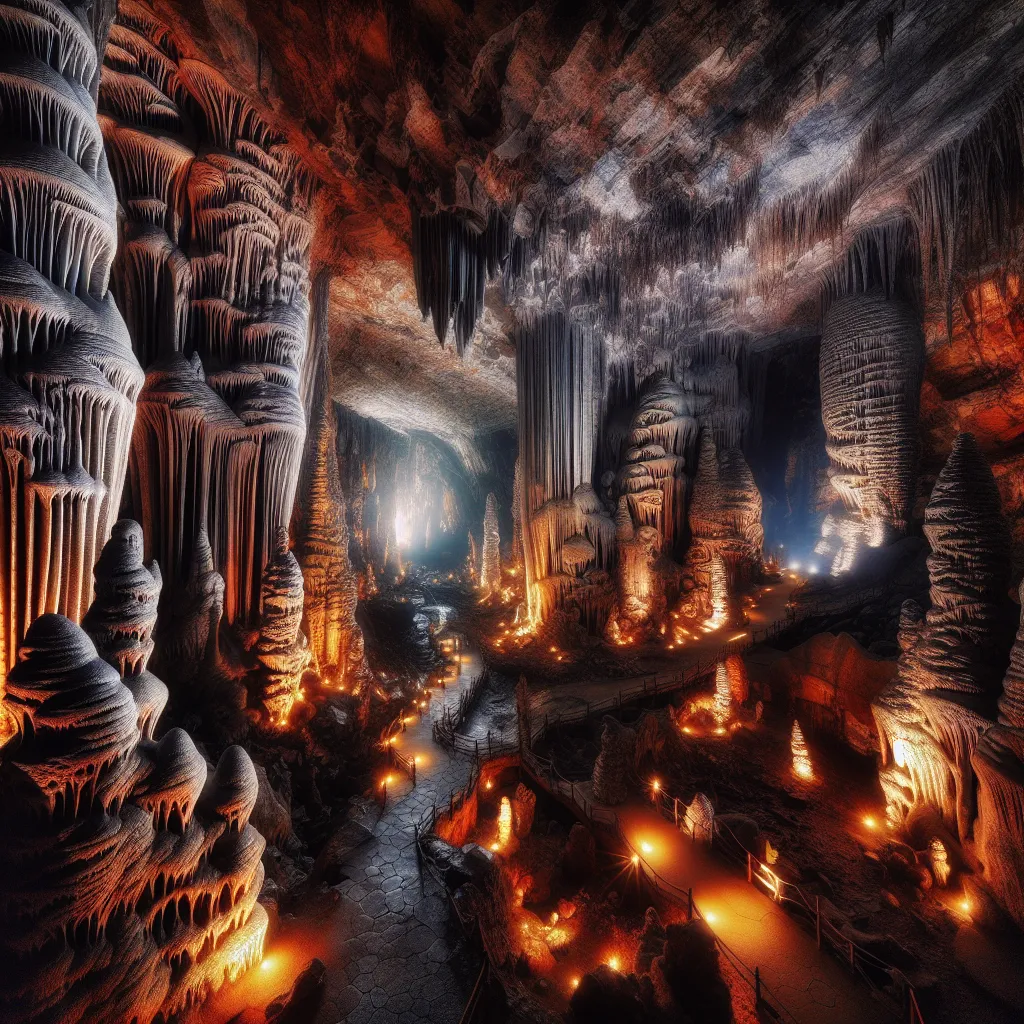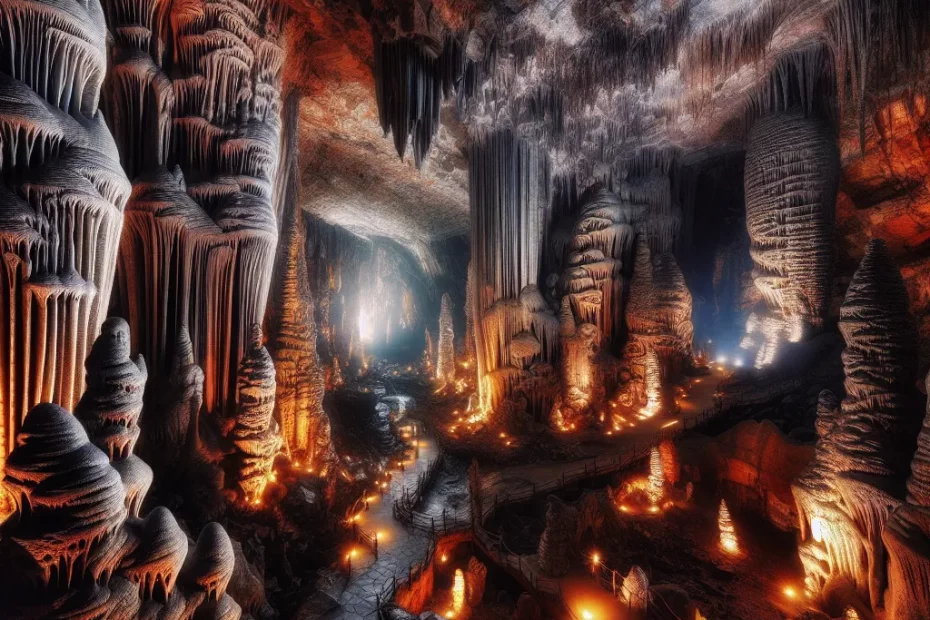Welcome to the fascinating world of Manjanggul Cave, where you can embark on a journey through the longest lava tube on Earth! Imagine walking through a natural underground wonderland, surrounded by unique rock formations that have been sculpted over thousands of years. As you explore this geological marvel, you’ll uncover the rich history and significance of lava tubes in understanding our planet’s past. Get ready to be amazed by the wonders that nature has created deep beneath the surface of Jeju Island. Let’s dive into the depths of Manjanggul Cave together and discover the secrets it holds!

Exploring the Geological Formation of Manjanggul Cave
Hey there, fellow explorers! Today, we’re diving deep into the fascinating world of Manjanggul Cave, home to the longest lava tube in the world. 🌋✨
Manjanggul Cave, located on the beautiful Jeju Island in South Korea, is a natural wonder that never fails to amaze visitors with its stunning geological formations. This incredible lava tube stretches an impressive 8.6 kilometers in length, making it a must-visit destination for anyone with a thirst for adventure and a love for the Earth’s natural wonders. 🌏🌟
As we venture into the depths of Manjanggul Cave, we are greeted by a mesmerizing display of lava stalactites and stalagmites that have been formed over thousands of years. These unique formations are a result of the cooling and solidification of lava flows that once surged through the cave, creating a breathtaking underground landscape that is unlike anything you’ve ever seen before. 🌌💫
The Formation of Manjanggul Cave
But what exactly caused the formation of Manjanggul Cave? Well, let’s break it down for you in simple terms. The cave was created over 200,000 years ago by a volcanic eruption from the nearby Hallasan Mountain. As the lava flowed rapidly downhill, it eventually cooled and hardened on the surface while the molten lava continued to flow beneath, eventually creating the vast tunnel that we now know as Manjanggul Cave. 🌋🔥
The geological significance of Manjanggul Cave cannot be overstated. It provides us with a rare glimpse into the Earth’s fiery past and offers valuable insights into the processes that shape our planet. By studying the unique formations within the cave, geologists and researchers can better understand the behavior of lava flows and the intricate ways in which they interact with the surrounding environment. 🌍🔬
So, the next time you find yourself on Jeju Island, make sure to pay a visit to Manjanggul Cave and witness the awe-inspiring beauty of this natural wonder. It’s a journey through time and space that will leave you with a newfound appreciation for the incredible forces that have shaped our world. 🌟🌿
Keep exploring, keep discovering, and never stop marveling at the wonders of our planet! 🌏✨
Discovering Unique Cave Features and Formations
Welcome to the fascinating world of Manjanggul Cave, home to some of the most extraordinary cave features and formations you’ll ever encounter! 🌋
The Longest Lava Tube in the World
As you venture deep into this underground wonder, you’ll be amazed by the sheer size of Manjanggul Cave. Stretching over 8.6 kilometers, it holds the prestigious title of being the longest lava tube in the world. Can you believe it? That’s longer than 53 football fields combined! 🏈
Magnificent Lava Stalactites
One of the most striking features you’ll notice as you explore the cave is the magnificent lava stalactites hanging from the ceiling. These unique formations were created thousands of years ago when molten lava dripped from the roof of the cave, slowly solidifying into stunning mineral formations. The sight of these natural wonders will leave you in awe! 😲
Ancient Lava Columns
But that’s not all – keep an eye out for the lava columns rising up from the ground like ancient stone pillars. These formations are a result of lava flow filling the cave and solidifying over time. Standing tall and proud, they add a sense of grandeur to the cave’s mystical ambiance. 🗿
Lava Flowstone Cascades
As you wander through the winding passages of Manjanggul Cave, don’t miss the lava flowstone cascades decorating the walls. These flowstone formations, created by mineral deposits left behind by flowing water, resemble frozen waterfalls, adding a touch of magic to the cave’s rugged beauty. It’s like stepping into a fairy tale! 🧚♂️
Lava Terraces
And let’s not forget about the lava terraces that line the cave floor, creating a mesmerizing landscape of rippling waves frozen in stone. These terraces, formed by layers of solidified lava, showcase the raw power and beauty of nature in its purest form. It’s a sight you won’t soon forget! 🌟
So, if you’re ready for an unforgettable underground adventure filled with wonder and awe, make sure to add Manjanggul Cave to the top of your bucket list. With its unique features and formations unlike anywhere else on Earth, it’s a journey you’ll cherish for a lifetime. Happy exploring! 🌏
Unveiling the Rich History of Manjanggul Cave
Welcome, fellow explorers, to the fascinating world of Manjanggul Cave, where history and nature intertwine to create a truly mesmerizing experience! This extraordinary underground marvel, located on Jeju Island in South Korea, boasts the title of being the longest lava tube in the world, stretching an impressive 8.928 kilometers in length. 🌋
The Geological Wonder
As we venture deeper into the depths of Manjanggul Cave, let us unravel the rich history that lies within its ancient walls. Formed approximately 200,000 to 300,000 years ago by the flow of lava from Hallasan, a shield volcano and the highest mountain in South Korea, this geological wonder offers us a glimpse into the Earth’s fiery past. 💥
A Sanctuary of the Past
The name “Manjanggul” itself holds significance, derived from the words “manjang” meaning “length” and “gul” meaning “cave,” perfectly encapsulating the essence of this natural masterpiece. Walking through its corridors, one can’t help but feel a sense of awe at the sheer magnitude of time and forces of nature that have shaped this underground spectacle. 🌏
Stories of Resilience
But the history of Manjanggul Cave goes beyond its geological origins. Throughout the years, this subterranean labyrinth has served as a sanctuary for locals during times of war and conflict, a refuge where families sought shelter and protection from the chaos above ground. The echoes of the past reverberate through the stalactites and stalagmites, whispering stories of resilience and survival. 🕯️
Scientific Wonders
In addition to its historical significance, Manjanggul Cave is also a treasure trove of scientific wonders. The cave’s unique ecosystem, characterized by diverse flora and fauna adapted to the darkness and humidity of the underground environment, provides researchers with valuable insights into the complexities of subterranean life. From rare species of blind albino crabs to delicate mosses clinging to the cave walls, each discovery adds to the tapestry of knowledge woven within these ancient chambers. 🦀
Embracing the Past
As we emerge from the depths of Manjanggul Cave, let us carry with us not only memories of its stunning beauty but also a newfound appreciation for the rich history that dwells within its rocky embrace. May we continue to explore, learn, and marvel at the wonders of the natural world, always remembering the ancient stories etched in stone beneath our feet. 🌟
Final Words
So, dear adventurers, until we meet again on our next journey of discovery, remember to tread lightly, respect the past, and embrace the mysteries that await in the heart of Manjanggul Cave. Let the echoes of history guide your steps and the spirit of exploration be your constant companion. 🌿
Understanding the Significance of Lava Tubes in Geological Studies
Hey there, fellow explorers! Today, we’re diving deep into the fascinating world of lava tubes and their importance in geological studies. 🌋 Let’s uncover the mysteries hidden beneath the Earth’s surface and understand why these natural wonders are more than just underground tunnels.
The Formation of Lava Tubes
Lava tubes are geological formations that are created when lava flows during volcanic eruptions. As the lava makes its way across the land, the outer layer cools and solidifies, while the molten lava continues to flow within, eventually leaving behind a hollow tube once the eruption ceases. These tubes can vary in size, with some reaching incredible lengths of several kilometers. Imagine walking through a tunnel formed by flowing lava – it’s like stepping into a time capsule of Earth’s fiery past! 🔥
Preservation of Geological Records
One of the key reasons why lava tubes are significant in geological studies is their role in preserving geological records. The conditions inside these tubes, with stable temperatures and protection from external elements, create the perfect environment for the preservation of important geological information. Scientists can study the layers of hardened lava within the tubes to gain insights into past volcanic activities, climate changes, and even the composition of the Earth’s crust. It’s like reading a history book written in stone! 📚
Insights into Lava Flows and Eruptions
Furthermore, lava tubes provide valuable insights into the behavior of lava flows and volcanic eruptions. By analyzing the shapes and structures of these tubes, geologists can better understand how lava moves, cools, and solidifies over time. This knowledge is crucial for predicting and mitigating the impact of future volcanic events, helping to keep communities safe from the destructive forces of nature. 🌍
Cultural and Ecological Significance
In addition to their scientific importance, lava tubes also hold cultural and ecological significance. Many of these underground passages are home to unique ecosystems, with rare species of plants and animals adapted to the dark, subterranean environment. By studying these ecosystems, researchers can learn more about the resilience of life in extreme conditions and the interconnectedness of all living organisms on our planet. It’s a reminder of the incredible diversity of life that exists even in the most unexpected places. 🌿
So, the next time you hear about a lava tube, remember that it’s not just a cool underground tunnel – it’s a window into the Earth’s past, a treasure trove of geological knowledge, and a sanctuary for unique forms of life. Let’s continue to explore, learn, and marvel at the wonders of our planet together! 🌏✨
As we delve into the depths of Manjanggul Cave, we are not just exploring a natural wonder, but unraveling the Earth’s history etched in its walls. The unique formations and features within the cave tell a story of ancient volcanic eruptions and the slow passage of time. By understanding the significance of lava tubes like Manjanggul Cave, we gain valuable insights into the geological processes that have shaped our planet over millions of years. So, next time you visit a cave, remember that you are stepping into a time capsule of Earth’s past, where every drip of water and every mineral deposit holds a tale of our planet’s fascinating history. Let’s continue to explore, learn, and marvel at the wonders that nature has to offer.
Move to main jeju information
